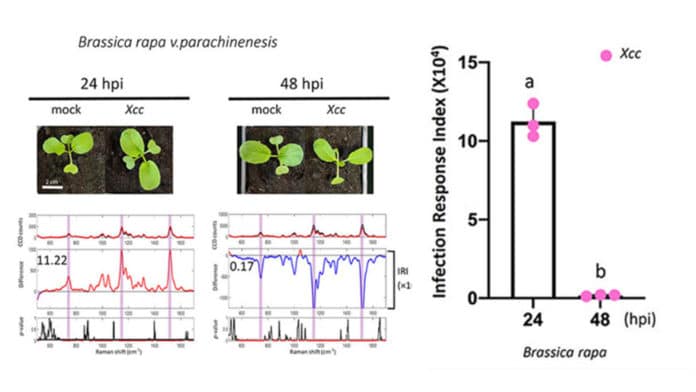Worldwide, a bacterial infection in crops is one of the significant contributors to agricultural yield losses. Developing methods for rapid and early detection of pathogen-infected crops could improve plant disease management and reduce crop loss.
A team of scientists recently came up with a method for the early detection of bacterial infection in crops. The method is based on Raman spectroscopy biomarkers and diagnostic algorithms. It enables the noninvasive and early diagnosis of bacterial infections in crop plants.
Unlike existing techniques, this new method is faster and accurate. It will allow the fast and selective removal of pathogen load. Plus, it could curb the further spread of disease to other neighboring crops.
MIT Professor Rajeev Ram, a DiSTAP principal investigator and co-corresponding author on the paper, said, “Traditionally, plant disease diagnosis involves a simple visual inspection of plants for disease symptoms and severity. Visual inspection methods are often ineffective, as disease symptoms usually manifest only at relatively later stages of infection when the pathogen load is already high, and reparative measures are limited.”
“Hence, new methods are required for rapid and early detection of bacterial infection. The idea would be akin to having medical tests to identify human diseases at an early stage, instead of waiting for visual symptoms to show, so that early intervention or treatment can be applied.”
Existing methods are time-consuming and non-adaptable for on-site field application. They are also expensive and need bulky equipment, which makes them impractical for use in agricultural farms.
Gajendra Pratap Singh, scientific director and principal investigator at DiSTAP and co-lead author, said, “At DiSTAP, we have developed a quantitative Raman spectroscopy-based algorithm that can help farmers to identify bacterial infection rapidly. The developed diagnostic algorithm uses Raman spectral biomarkers and can be easily implemented in cloud-based computing and prediction platforms. It is more effective than existing techniques as it enables accurate identification and early detection of bacterial infection, both of which are crucial to saving crop plants that would otherwise be destroyed.”
The method offers a precise and simple yes-or-no response when used to test for bacterial infections in crops. Scientists hope that this method could potentially improve plant disease management. It could be promising in reducing agricultural yield loss and increasing productivity.
Scientists tested the efficiency of the method on several edible plants, such as choy sum.
DiSTAP and TLL principal investigator and co-corresponding author Rajani Sarojam said, “The results showed that the Raman spectroscopy-based method could swiftly detect and quantify innate immunity response in plants infected with bacterial pathogens. We believe that this technology will be beneficial for agricultural farms. It could increase their productivity by reducing their yield loss due to plant diseases.”
The study was done by scientists from Disruptive and Sustainable Technologies for Agricultural Precision (DiSTAP) Interdisciplinary Research Group (IRG) of Singapore-MIT Alliance for Research and Technology (SMART), MIT’s research enterprise in Singapore, and their local collaborators from Temasek Life Sciences Laboratory (TLL).
Journal Reference:
- Pil Joong Chung et al. Rapid Detection and Quantification of Plant Innate Immunity Response Using Raman Spectroscopy. DOI: 10.3389/fpls.2021.746586
